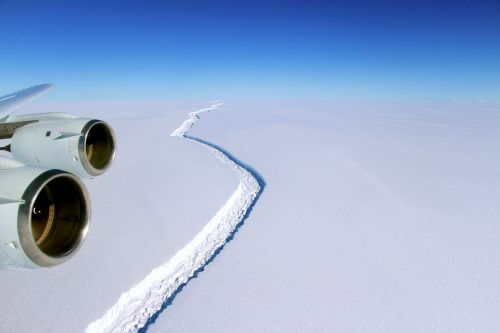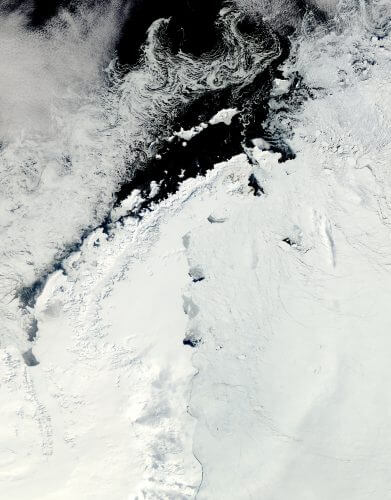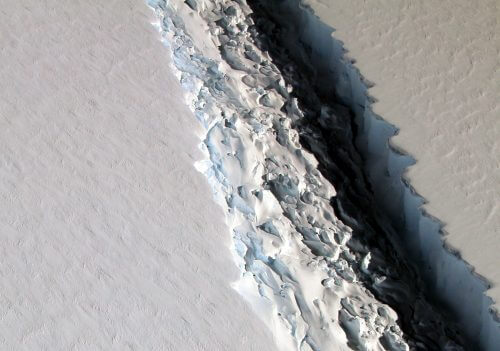A huge ice shelf in Antarctica has been cracking at a rapid rate in recent months and is close to breaking and collapsing into the sea. Experts warn that breaking it will start a chain of events that will significantly affect the sea level on Earth.

By Maya Falah, Angle, Science and Environment News Agency
NASA, the American space agency, recently announced that the year 2016 was also able to fulfill its mission and take from 2015 the title "The hottest year so far". despite efforts world to reduce the amount of greenhouse gases we emit to the air in the processes of burning fossil fuels - which cause the earth to warm - the average global temperature still continues to rise.
One of the most prominent effects of this warming is the melting of the ice at the poles, which is expected to cause sea levels to rise (some speculate thatA significant increase will occur already in the first half of this century) and following it the disappearance of large areas from the continents, the destruction of infrastructure, residential areas and tourist sites and the formation of a mass wave of hundreds of millions of refugees whose homes will be lost under the rising sea. Reports on the state of the poles that are published every year continue to point to a high rate of melting in the poles and in Greenland. A few days ago he became famous that the floating ice at both poles has now reached an all-time negative record, this after the poles suffered from much warmer than usual winter temperatures this year.
A crack of 160 kilometers
Larsen C is a large ice shelf located at the edge of the Antarctic continent (toward South America). In recent months, he has been a cause of concern for experts, because a huge crack that opened in it has been growing recently at a fast rate and is expected to lead very soon to the breaking of the shelf.
The ice shelves are thick surfaces of ice that form above the surface of the water in the part adjacent to the frozen continent and originate from the water of the glaciers and from the ice surfaces and the snow that has piled up on them. The shelves are used by the glaciers as a kind of support that attaches them to the continent and prevents them from sliding into the sea and thus raising its level. Such shelves currently exist in Antarctica, Canada, northeastern Russia and Greenland.

In recent years, the ice sheets have been slowly breaking up. Due to the warming of the earth and the sea water, the ice of the shelves melts and creates cracks in the shelf. As these cracks deepen and lengthen, the shelf's grip on the continent weakens and it breaks and collapses into the sea. In the last two months, the crack that opened in Larsen III has lengthened by about 30 kilometers. The huge fissure currently stands at a length of about 160 kilometers and reaches in some parts up to a width of more than 3 kilometers. In addition, the depth of the crack reaches right up to the floor of the glacier, which is about half a kilometer thick. According to the researchers, the shelf is expected to collapse from the load, and a large part of it is expected to collapse into the water in the coming months.
Larsen A and B, other smaller ice shelves on the same peninsula, broke up already in the 90s and early 2000s. Since the ice shelves are a kind of "gatekeepers" for the glaciers adjacent to them, the collapse of the shelf will also affect the ice surface adjacent to it. The surface near Larsen C is one of the largest ice surfaces recorded to date, and according to experts the collapse of the shelf will release a sort of "plug" that holds the glacier and will allow it to slide into the sea.
This is what worries the experts, even more than the collapse of the shelf itself: the sliding of the ice surface from the continent and its drift into the sea is expected to have a substantial effect on the rise of the sea level, because the size of the ice surface and its volume - which until now have not affected the sea level since it is mostly outside the water - are definitely expected to affect the sea level and accelerate its rate of rise.
Climate change or behavior change?
The warming of the earth's temperature is expected to continue to rise, and by the end of this century to reach a range of 1.5 to 4 degrees Celsius above the temperature values that prevailed on the earth during the days of the industrial revolution. If indeed this warming occurs in full force, the melting of the glaciers is only expected to worsen, and then sea level rise will be just one of a variety of catastrophes expected for humanity during the century.

In December 2015, the Paris Agreement was signed by the vast majority of the world's countries, which seeks to slow down the rate of warming and limit it to only 2-1.5 degrees by the end of the century. If that happens, we have a chance to slow down the warming. This will happen only if the countries of the world - and mainly the great powers that are currently responsible for the majority of greenhouse gas emissions in the world - respect the agreement and invest efforts within their borders in reducing emissions.
The responsibility does not rest only on the leaders of the big countries. We too can contribute our part to slowing climate change. "Each and every one of us can do many things that will cumulatively bring about a significant change for the better," says Prof. Yoav Yair, Dean of the School of Sustainability at the Interdisciplinary Center in Herzliya. "It involves slowly changing our lifestyles. It starts with awareness of saving energy - less waste of electricity leads to less pollution and less greenhouse gases. It is better to turn off the light where it is not needed and close the air conditioner when you leave the house. This continues through the reduction of travel by private vehicle - for example bicycles or switching to public transport, which reduces air pollution and fuel consumption. We are all aware today of separating household waste and recycling, to which we must add the reduction of consumption and a reduction in food waste (On average, households throw away about 500 percent of the food they buy).
"This is a partial and not complete list," adds Prof. Yair. "You can find a lot more information about what everyone can do. The cumulative contribution is huge and significant - if each of Israel's citizens reduces, for example, their carbon dioxide emissions by one hundred kilograms per year, the total amount will reach millions of tons, and that is certainly significant.'

12 תגובות
It doesn't rise over the years, it's funny, it rises gradually for a few more years, the level will continue to rise, you also don't notice that the earth will cool down, but that's exactly what will happen until 2020, you don't notice it, it will happen gradually
In recent times, omniscient (my father) has been added to the commenting readers
that in many articles he has an opinion or criticism,
His opinion often prompts other readers to comment
and enter into a debate, it's good because more commenters, more readers,
more circulation to be known,
But nevertheless it is worth repeating things I wrote before:
On the difference between debate and discussion:
A discussion is an exchange of opinions between people who know and want to expand the information,
After all, a debate is an exchange of words between - - - and ours!
my father
Is that good enough for you?
https://climate.nasa.gov/vital-signs/sea-level/
What about the links to the articles?
my father
What proof will you provide? The sea level is increasing today by 3 mm per year. This rate is on the rise. There are two main reasons for the increase: the warming of the sea, and the increase in the amount of water in the sea.
Do you really want to argue about that?
Has anyone calculated if all the ice in Antarctica will melt - how much water is that, and what percentage is it of the volume of the world's oceans?
And if it changes the height of the sea level all over the world and by how much?
There are always scientists who predict this but I have never seen such a calculation.
I have not seen any proof that the sea level is rising over the years, after all with global warming I would expect the sea level to rise.
To my father
Regardless of how significant it is after all, the crack is 160 kilometers long and getting longer year by year, not the glacier. Like 3 kilometers thick
0.5 kilometers thick, 3 kilometers wide, 160 kilometers long - that's 240 cubic kilometers of ice.
This is about fifty times the Kinneret (a little less if you calculate the density of ice compared to water)
But compared to the volume of the world's oceans, this is not so significant that it will cause the sea level to rise.
What can happen is a tsunami wave, but it depends on the momentum of the shelf when it falls into the sea.
The content of the article is interesting. I'm already waiting to see the shelf break, I hope someone will film it happening relatively close (unlike in the past there were only satellite images), it will be a spectacular sight.
As for the other messages, everything is of course based on the assumption that the increase in temperature is the fault of humans in general, and fuel consumption in particular. Al Gore's bank account thanks Prof.
A. Ben Ner
You are absolutely right!
to edward
Your rude, blunt and wrong(!), words towards Fr. Yoav Yair are in the exam
"Shooting at our forces inside the APC".
You are rudely attacking a person who dedicates his life to the issue of environmental quality and sustainability.
Even if your professional opinion differs from his, it would be appropriate for you to express yourself in a more moderate and polite manner.
And to the very point,
Prof. Yoav Yair is right in his position if only for the simple reason that, only broad public awareness,
As Fr. Yoav Yair requires and outlines, you will allow a huge amount of money to be diverted, as you request,
for research and implementation of an active policy to preserve the quality of the environment. In the absence of social support
and a very broad political approach to the issue, there is no chance of realizing it.
Professor Yoav Yair, you are misleading and arrogant. Only because of scientists like you who deal with nonsense we will reach a disaster. The little frugality of the citizens is not what will save the planet. It should be understood: we are already in a state of total war to destroy the ecology. The solution should be global (finding efficient energy solutions such as fusion and blocking sunlight in space). To do this, increased efforts must be invested in theoretical and practical research. it costs money? No problem: imposing a global tax of 20 to 40 percent on everyone. For a country that has no money, which will face an expected war against it. She will find the necessary money. That scientists like you, instead of spouting nonsense, will shut themselves up in laboratories and develop technologies that will advance everyone. And believe me, when I go to sleep, I shut down the computer, and turn off the lights in the house and turn off the air conditioner when I leave the house. I still haven't received a message from the nation that I saved the Antarctic ice shelves.
In short, distinguished professor, go to work and donate a large part of your salary to scientific development. It will really help.
What to do that the Israeli government encourages the use of private vehicles in order to avoid taxes on fuel and purchases?